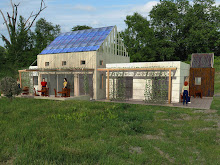
The exceptionally cold winter continues. But there have been quite a few brilliantly sunny days and that allows for considerable solar gain for the passive design of the Unity House.
We had a retreat here on Saturday morning for the Faculty Planning Committee of Unity College. We're undergoing a thoughtful and wonderful process of revising our curriculum to meet the needs of a new generation of sustainability leadership. Mick Womersley, Associate Professor of Human Ecology, and generalist on all things related to ecological economics, energy and sustainability, was a participant. Before our discussions started, Mick was roaming around the house with a temperature gun, checking out the floors, windows, and walls. When I first saw him pull the thing from his pocket, I wasn't sure exactly what he was doing. Indeed, he looked like some kind of sustainability ghost-buster! Maybe that's an emerging career in this field.
Anyway, he told me what he was doing, handed me the thermometer gun, and I started flashing it as well, delighted in the simple pleasure of attaching numbers to walls and windows. Mick offered to lend me the instrument (Unity College has several of them). I took up his offer and spent Sunday (another icy cold, but clear day) taking readings throughout the day at approximately two hour intervals.
Here's what I recorded. At 9 AM the temperature outside was -9 Farenheit. The south facing window, just catching a few rays of morning sun was 73 F and the north facing window at our back entrance was 43. I placed a chair in front of the south facing window. The upholstery was 89F (a nice place to get some heat on your back in the morning) whereas the other couches were 64F. I checked out the floor throughout the house and it ranged from 56-64F. The walls were 63-66. The room temperature was 63, our default setting. The Hallowell heat pump was off although it had been on earlier in the morning. Incidentally, it would not come on again until 10 PM as the house absorbed and contained so much heat during the day.
Here are the remaining readings. By the way, the cold floor spot is the only place in the house that receives no sun. For most of the day, the floor temperature is the same as room temperature, but much warmer in the sunny spots as the house accumulates sun.
10:30 AM 3F outside
Windows 49-85
Couches 71-113
Floors 54-68
Walls 65-67
Room 65
12:00 PM 19F outside
Windows 52-102
Couches 71-113
Floors 54-79
Walls 65-68
Room 68
2:30 PM 21F outside
Windows 55-108
Couches 73-104
Floors 55-81
Walls 65-70
Room 70
6:00 PM 20F outside (The sun has set)
Windows 49-56
Couches 66
Floors 53-73
Walls 65-66
Room 66
What do I conclude from all of this?
(1) The windows are doing a pretty darn good job and there isn't too much heat loss from them
(2) The walls absorb and retain sufficient heat as they are almost precisely the same temperature as the room
(3) The floors effectively absorb and radiate heat
(4) The furniture temperature reflects room temperature, but absorbs heat when in direct sunlight.
What we should do next is trace the power needs throughout the course of the day.
More importantly, interacting with the house in this way helps us better understand the performance of the house.
Yet there's something very important that's missing here. What is the relationship between how the Unity House uses power and the regional/national grid?
I'm delighted to see that Thomas Friedman's excellent new book, Hot, Flat and Crowded is a national best seller. It's an insightful and accessible plea for a comprhensive national strategy for energy innovation as a means for America to regain its leadership in the global economy. Friedman also understands the challenge of biodiversity and climate change and he provides brilliant solutions-based, practical, and wide-ranging policy suggestions. I was so impressed with the book that I gave copies to every Unity College Board of Trustee and I'm using it in a seminar I'm teaching on Environmental Security.
Back to the temperature gun and the necessity of measuring power input and output as well. Friedman describes how America needs an "Energy Internet" which will allow comprehensive monitoring of energy usage. This will not only allow us to conserve unprecedented amounts of energy, but it will allow the consumer to take part in a community/cooperative venture that brings energy usage to the most specific and tangible consumer level.
We thought about wiring the Unity House accordingly, but the cost was prohibitive, and we decided that we'd rather invest in ecological landscaping and other features. However, the technology should be available for every American homeowner to have utility-provided "black boxes" not unlike your cable or satellite TV setup that are connected to both your computer and the national grid. The whole point of the Unity House (and other sustainable energy projects) is to live experimentally, live with more energy awareness, and to take educational leadership to promote sustainable alternatives.
As we learn more about the Unity House, we will take on some of these initiatives. we'll look for inexpensive energy monitoring alternatives, and we'll report on what we're learning. We'll continue to pursue what one reporter described as "obsessive transparency."
Oh, and as you can see, our dog Paco really likes sitting on a warm couch on an icy cold winter day!


.jpg)
